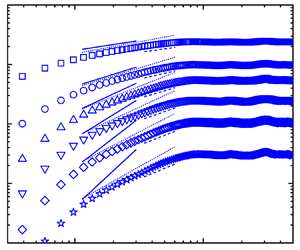Article contents
Scaling law of structure function of Richtmyer–Meshkov turbulence
Published online by Cambridge University Press: 29 September 2023
Abstract

The scaling law of the structure function of Richtmyer–Meshkov (RM) turbulence is investigated both numerically and theoretically. High-fidelity simulations with a minimum-dispersion, adaptive-dissipation scheme are first performed. Results show that the mixing width experiences an exponential growth and the turbulent kinetic energy has a visible  $-3/2$ spectrum. The scalar field exhibits a greater degree of intermittency than the velocity field, and also the small-scale statistics suffer a larger influence of large scales. Visible differences in the scaling law of the structure function among the RM turbulence and other types of turbulence are observed, which reveal the unique characteristic of RM turbulence. A phenomenological theory, which gives the spatial and temporal scaling laws of the structure functions of velocity and scalar of RM turbulence, is developed for the first time by introducing an external agent. The spatial scaling exponents of structure functions from simulation deviate from the Kolmogorov exponents, but are quite close to the RM-modified anomalous exponents. This demonstrates the validity of the present phenomenological theory. The temporal scaling exponents of structure functions first meet the RM-modified anomalous exponents, and then approach the Kolmogorov–Obukhov–Corrsin non-intermittent ones.
$-3/2$ spectrum. The scalar field exhibits a greater degree of intermittency than the velocity field, and also the small-scale statistics suffer a larger influence of large scales. Visible differences in the scaling law of the structure function among the RM turbulence and other types of turbulence are observed, which reveal the unique characteristic of RM turbulence. A phenomenological theory, which gives the spatial and temporal scaling laws of the structure functions of velocity and scalar of RM turbulence, is developed for the first time by introducing an external agent. The spatial scaling exponents of structure functions from simulation deviate from the Kolmogorov exponents, but are quite close to the RM-modified anomalous exponents. This demonstrates the validity of the present phenomenological theory. The temporal scaling exponents of structure functions first meet the RM-modified anomalous exponents, and then approach the Kolmogorov–Obukhov–Corrsin non-intermittent ones.
JFM classification
- Type
- JFM Papers
- Information
- Copyright
- © The Author(s), 2023. Published by Cambridge University Press
References
- 3
- Cited by





